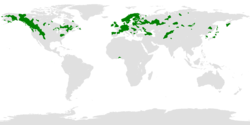Biology:Common hawker
| Common hawker | |
|---|---|

| |
| Scientific classification | |
| Domain: | Eukaryota |
| Kingdom: | Animalia |
| Phylum: | Arthropoda |
| Class: | Insecta |
| Order: | Odonata |
| Infraorder: | Anisoptera |
| Family: | Aeshnidae |
| Genus: | Aeshna |
| Species: | A. juncea
|
| Binomial name | |
| Aeshna juncea | |

| |
| Range of Aeshna juncea | |
| Synonyms | |
|
Aeshna rustica Zetterstedt, 1840 | |
The common hawker,[2] moorland hawker[1] or sedge darner[1] (Aeshna juncea) is one of the larger species of hawker dragonflies. It is native to Palearctic (from Ireland to Japan) and northern North America. The flight period is from June to early October.
It is 74 millimetres (2.9 in) long with a brown body. The male has a black abdomen with paired blue and yellow spots on each abdominal segment, and narrow stripes along the dorsal surface of the thorax. In the female, the abdomen is brown with yellow or sometimes green or blue spots. The wings of both sexes display a yellow costa (the major vein running along the leading edge of the wings). This species lacks the green thorax stripes of the southern hawker.
Female common hawkers will sometimes dive out of the sky and feign death in order to avoid copulating with males.[3][4]
References
- ↑ 1.0 1.1 1.2 Boudot, J.-P. (2017). "Aeshna juncea". IUCN Red List of Threatened Species 2017: e.T165518A65835376. doi:10.2305/IUCN.UK.2017-3.RLTS.T165518A65835376.en. https://www.iucnredlist.org/species/165518/65835376. Retrieved 20 November 2021.
- ↑ "Common Hawker". British Dragonfly Society. http://www.british-dragonflies.org.uk/species/common-hawker.
- ↑ "Female dragonflies fake sudden death to avoid male advances" (in en-US). New Scientist. https://www.newscientist.com/article/2129185-female-dragonflies-fake-sudden-death-to-avoid-male-advances/.
- ↑ Khelifa, Rassim (2017-06-01). "Faking death to avoid male coercion: extreme sexual conflict resolution in a dragonfly" (in en). Ecology 98 (6): 1724–1726. doi:10.1002/ecy.1781. ISSN 1939-9170. PMID 28436995.
- "Aeshna juncea". Integrated Taxonomic Information System. https://www.itis.gov/servlet/SingleRpt/SingleRpt?search_topic=TSN&search_value=185981. Retrieved 6 February 2006.
- "Aeshna juncea". DragonflyIreland. http://www.habitas.org.uk/dragonflyireland/5624.htm.
External links
Wikidata ☰ Q732875 entry
 |



